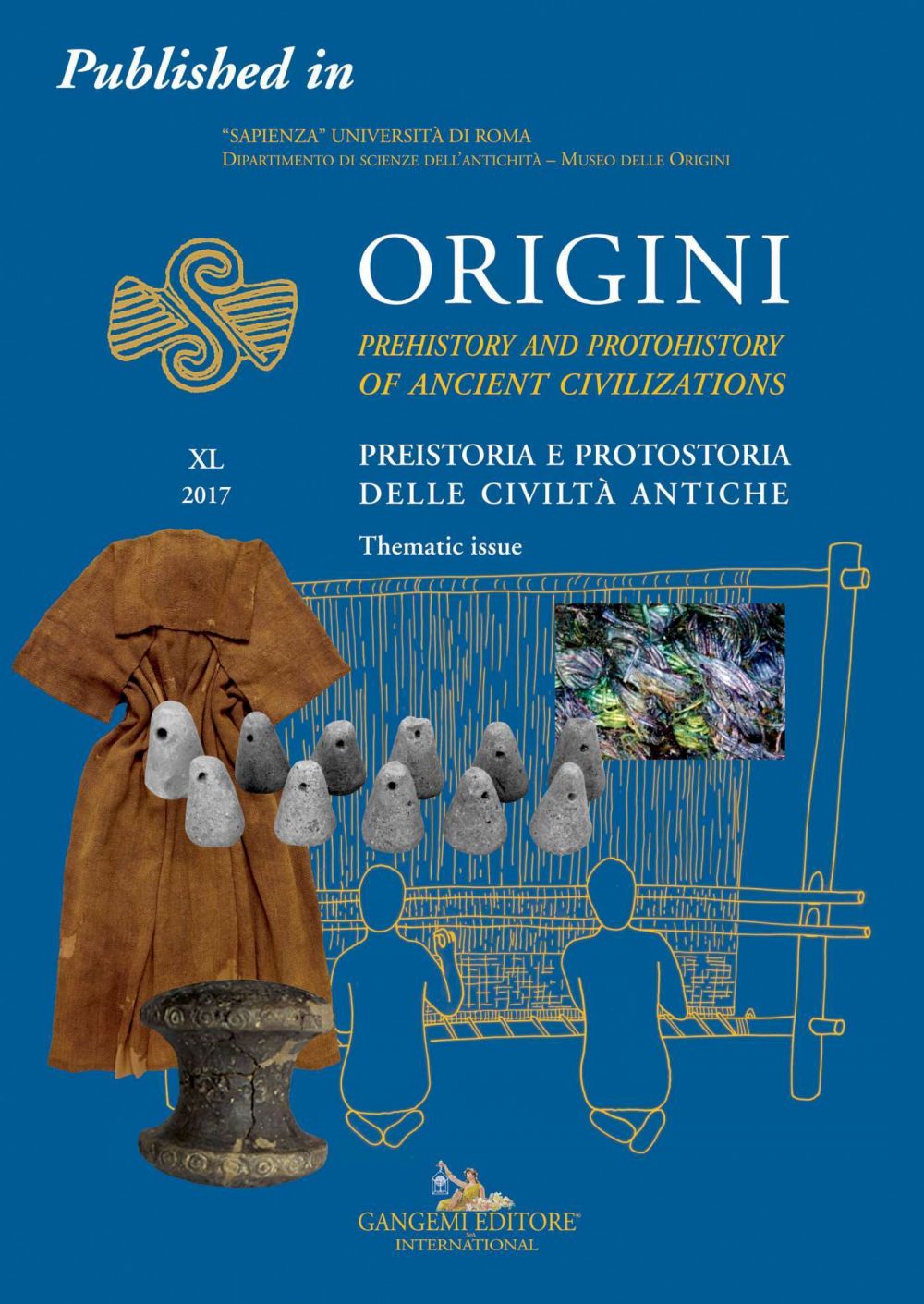Motion capture and textile experimental archaeology, a possible combination
Published in Origini n. XL/2017. Rivista annuale del Dipartimento di Scienze dell’Antichità – “Sapienza” Università di Roma | Preistoria e protostoria delle civiltà antiche – Prehistory and protohistory of ancient civilizations
Editore:
Anno:
2019
ISBN:
9788849243048
DRM:
Adobe (Il file scaricato ha estensione .acsm e viene convertito nel formato acquistato con l' installazione sul proprio eReader)
Editore:
Anno:
2019
ISBN:
9788849243048
DRM:
Adobe (Il file scaricato ha estensione .acsm e viene convertito nel formato acquistato con l' installazione sul proprio eReader)
Descrizione
Published in Origini n. XL/2017. Rivista annuale del Dipartimento di Scienze dell’Antichità – “Sapienza” Università di Roma | Preistoria e protostoria delle civiltà antiche – Prehistory and protohistory of ancient civilizations | Understanding craft and craft processes in ancient societies is crucial; textiles must be seen as dynamic objects representing past actions and processes. Important is the way we can illuminate how the body and mind are involved in the production processes behind ancient technology and the creation of objects. A combination of craft knowledge with experimental archaeology has already proved to be a significant method enabling new interpretations and perspectives on the archaeologically invisible parts of ancient societies. Experimental archaeology has a long and solid tradition in Denmark and tests have given new information and insights into textile tool function and made invisible textile production visible. However, new and innovative methods are still necessary in order to come closer to both ancient societies and the people themselves. Computer applications in archaeology can enhance our knowledge of the complexity and variety of artefacts, their production, and how various craft traditions develop over time, yielding new insights and perspectives applicable to ancient societies as well as to traditional craft today. In this article, we demonstrate how motion capture (MoCap) can be applicable on textile experimental archaeology research.
Tags
Dello stesso autore
MOTION CAPTURE AND TEXTILE EXPERIMENTAL ARCHAEOLOGY, A POSSIBLE COMBINATION
Published in Origini n. XL/2017. Rivista annuale del Dipartimento di Scienze dell’Antichità – “Sapienza” Università di Roma | Preistoria e protostoria delle civiltà antiche – Prehistory and protohistory of ancient civilizations
Published in Origini n. XL/2017. Rivista annuale del Dipartimento di Scienze dell’Antichità – “Sapienza” Università di Roma | Preistoria e protostoria delle civiltà antiche – Prehistory and protohistory of ancient civilizations
6.99 €
39
-41
 MOTION CAPTURE AND TEXTILE EXPERIMENTAL ARCHAEOLOGY, A POSSIBLE COMBINATION
Published in Origini n. XL/2017. Rivista annuale del Dipartimento di Scienze dell’Antichità – “Sapienza” Università di Roma | Preistoria e protostoria delle civiltà antiche – Prehistory and protohistory of ancient civilizations
MOTION CAPTURE AND TEXTILE EXPERIMENTAL ARCHAEOLOGY, A POSSIBLE COMBINATION
Published in Origini n. XL/2017. Rivista annuale del Dipartimento di Scienze dell’Antichità – “Sapienza” Università di Roma | Preistoria e protostoria delle civiltà antiche – Prehistory and protohistory of ancient civilizations
Eva Andersson Strand, Gangemi Editore
 MOTION CAPTURE AND TEXTILE EXPERIMENTAL ARCHAEOLOGY, A POSSIBLE COMBINATION
Published in Origini n. XL/2017. Rivista annuale del Dipartimento di Scienze dell’Antichità – “Sapienza” Università di Roma | Preistoria e protostoria delle civiltà antiche – Prehistory and protohistory of ancient civilizations
MOTION CAPTURE AND TEXTILE EXPERIMENTAL ARCHAEOLOGY, A POSSIBLE COMBINATION
Published in Origini n. XL/2017. Rivista annuale del Dipartimento di Scienze dell’Antichità – “Sapienza” Università di Roma | Preistoria e protostoria delle civiltà antiche – Prehistory and protohistory of ancient civilizationsEva Andersson Strand, Gangemi Editore
6,99 €
ORIGINI - XL
Preistoria e protostoria delle civiltà antiche - Prehistory and protohistory of ancient civilizations
Preistoria e protostoria delle civiltà antiche - Prehistory and protohistory of ancient civilizations
Marcella Frangipane,
Eva Andersson Strand,
Giovanna Bagnasco Gianni,
Daniela Bordoni,
Maria Cataldi,
Elena Ciccarelli,
Alessio De Cristofaro,
Anna Maria De Lucia Brolli,
Helga Di Giuseppe,
Giulio M. Facchetti,
Vanessa Forte,
Giovanna Gambacurta,
Margarita Gleba,
Karina Grömer,
Paolo Maria Guarrera,
Carolina Larsson,
Romina Laurito,
Cristina Lemorini,
Stefan Lindgren,
Maria Rosaria Luberto,
Maria Rosa Lucidi,
Alessandro Mandolesi,
Ulla Mannering,
Ilaria Menale,
Francesco Meo,
Assunta Perilli,
Patrizia Petitti,
Alessandra Piergrossi,
Ettore Pizzuti,
Alessandro Quercia,
Carlo Rescigno,
Stella Spantidaki,
Jacopo Tabolli
29.99 €
39
-41
 ORIGINI - XL
Preistoria e protostoria delle civiltà antiche - Prehistory and protohistory of ancient civilizations
ORIGINI - XL
Preistoria e protostoria delle civiltà antiche - Prehistory and protohistory of ancient civilizations
Marcella Frangipane, Gangemi Editore
 ORIGINI - XL
Preistoria e protostoria delle civiltà antiche - Prehistory and protohistory of ancient civilizations
ORIGINI - XL
Preistoria e protostoria delle civiltà antiche - Prehistory and protohistory of ancient civilizationsMarcella Frangipane, Gangemi Editore
29,99 €
MOTION CAPTURE AND TEXTILE EXPERIMENTAL ARCHAEOLOGY, A POSSIBLE COMBINATION
Published in Origini n. XL/2017. Rivista annuale del Dipartimento di Scienze dell’Antichità – “Sapienza” Università di Roma | Preistoria e protostoria delle civiltà antiche – Prehistory and protohistory of ancient civilizations
Published in Origini n. XL/2017. Rivista annuale del Dipartimento di Scienze dell’Antichità – “Sapienza” Università di Roma | Preistoria e protostoria delle civiltà antiche – Prehistory and protohistory of ancient civilizations
6.99 €
39
-41
 MOTION CAPTURE AND TEXTILE EXPERIMENTAL ARCHAEOLOGY, A POSSIBLE COMBINATION
Published in Origini n. XL/2017. Rivista annuale del Dipartimento di Scienze dell’Antichità – “Sapienza” Università di Roma | Preistoria e protostoria delle civiltà antiche – Prehistory and protohistory of ancient civilizations
MOTION CAPTURE AND TEXTILE EXPERIMENTAL ARCHAEOLOGY, A POSSIBLE COMBINATION
Published in Origini n. XL/2017. Rivista annuale del Dipartimento di Scienze dell’Antichità – “Sapienza” Università di Roma | Preistoria e protostoria delle civiltà antiche – Prehistory and protohistory of ancient civilizations
Eva Andersson Strand, Gangemi Editore
 MOTION CAPTURE AND TEXTILE EXPERIMENTAL ARCHAEOLOGY, A POSSIBLE COMBINATION
Published in Origini n. XL/2017. Rivista annuale del Dipartimento di Scienze dell’Antichità – “Sapienza” Università di Roma | Preistoria e protostoria delle civiltà antiche – Prehistory and protohistory of ancient civilizations
MOTION CAPTURE AND TEXTILE EXPERIMENTAL ARCHAEOLOGY, A POSSIBLE COMBINATION
Published in Origini n. XL/2017. Rivista annuale del Dipartimento di Scienze dell’Antichità – “Sapienza” Università di Roma | Preistoria e protostoria delle civiltà antiche – Prehistory and protohistory of ancient civilizationsEva Andersson Strand, Gangemi Editore
6,99 €
ORIGINI - XL
Preistoria e protostoria delle civiltà antiche - Prehistory and protohistory of ancient civilizations
Preistoria e protostoria delle civiltà antiche - Prehistory and protohistory of ancient civilizations
Marcella Frangipane,
Eva Andersson Strand,
Giovanna Bagnasco Gianni,
Daniela Bordoni,
Maria Cataldi,
Elena Ciccarelli,
Alessio De Cristofaro,
Anna Maria De Lucia Brolli,
Helga Di Giuseppe,
Giulio M. Facchetti,
Vanessa Forte,
Giovanna Gambacurta,
Margarita Gleba,
Karina Grömer,
Paolo Maria Guarrera,
Carolina Larsson,
Romina Laurito,
Cristina Lemorini,
Stefan Lindgren,
Maria Rosaria Luberto,
Maria Rosa Lucidi,
Alessandro Mandolesi,
Ulla Mannering,
Ilaria Menale,
Francesco Meo,
Assunta Perilli,
Patrizia Petitti,
Alessandra Piergrossi,
Ettore Pizzuti,
Alessandro Quercia,
Carlo Rescigno,
Stella Spantidaki,
Jacopo Tabolli
29.99 €
39
-41
 ORIGINI - XL
Preistoria e protostoria delle civiltà antiche - Prehistory and protohistory of ancient civilizations
ORIGINI - XL
Preistoria e protostoria delle civiltà antiche - Prehistory and protohistory of ancient civilizations
Marcella Frangipane, Gangemi Editore
 ORIGINI - XL
Preistoria e protostoria delle civiltà antiche - Prehistory and protohistory of ancient civilizations
ORIGINI - XL
Preistoria e protostoria delle civiltà antiche - Prehistory and protohistory of ancient civilizationsMarcella Frangipane, Gangemi Editore
29,99 €
MOTION CAPTURE AND TEXTILE EXPERIMENTAL ARCHAEOLOGY, A POSSIBLE COMBINATION
Published in Origini n. XL/2017. Rivista annuale del Dipartimento di Scienze dell’Antichità – “Sapienza” Università di Roma | Preistoria e protostoria delle civiltà antiche – Prehistory and protohistory of ancient civilizations
Published in Origini n. XL/2017. Rivista annuale del Dipartimento di Scienze dell’Antichità – “Sapienza” Università di Roma | Preistoria e protostoria delle civiltà antiche – Prehistory and protohistory of ancient civilizations
6.99 €
39
-41
 MOTION CAPTURE AND TEXTILE EXPERIMENTAL ARCHAEOLOGY, A POSSIBLE COMBINATION
Published in Origini n. XL/2017. Rivista annuale del Dipartimento di Scienze dell’Antichità – “Sapienza” Università di Roma | Preistoria e protostoria delle civiltà antiche – Prehistory and protohistory of ancient civilizations
MOTION CAPTURE AND TEXTILE EXPERIMENTAL ARCHAEOLOGY, A POSSIBLE COMBINATION
Published in Origini n. XL/2017. Rivista annuale del Dipartimento di Scienze dell’Antichità – “Sapienza” Università di Roma | Preistoria e protostoria delle civiltà antiche – Prehistory and protohistory of ancient civilizations
Eva Andersson Strand, Gangemi Editore
 MOTION CAPTURE AND TEXTILE EXPERIMENTAL ARCHAEOLOGY, A POSSIBLE COMBINATION
Published in Origini n. XL/2017. Rivista annuale del Dipartimento di Scienze dell’Antichità – “Sapienza” Università di Roma | Preistoria e protostoria delle civiltà antiche – Prehistory and protohistory of ancient civilizations
MOTION CAPTURE AND TEXTILE EXPERIMENTAL ARCHAEOLOGY, A POSSIBLE COMBINATION
Published in Origini n. XL/2017. Rivista annuale del Dipartimento di Scienze dell’Antichità – “Sapienza” Università di Roma | Preistoria e protostoria delle civiltà antiche – Prehistory and protohistory of ancient civilizationsEva Andersson Strand, Gangemi Editore
6,99 €
ORIGINI - XL
Preistoria e protostoria delle civiltà antiche - Prehistory and protohistory of ancient civilizations
Preistoria e protostoria delle civiltà antiche - Prehistory and protohistory of ancient civilizations
Marcella Frangipane,
Eva Andersson Strand,
Giovanna Bagnasco Gianni,
Daniela Bordoni,
Maria Cataldi,
Elena Ciccarelli,
Alessio De Cristofaro,
Anna Maria De Lucia Brolli,
Helga Di Giuseppe,
Giulio M. Facchetti,
Vanessa Forte,
Giovanna Gambacurta,
Margarita Gleba,
Karina Grömer,
Paolo Maria Guarrera,
Carolina Larsson,
Romina Laurito,
Cristina Lemorini,
Stefan Lindgren,
Maria Rosaria Luberto,
Maria Rosa Lucidi,
Alessandro Mandolesi,
Ulla Mannering,
Ilaria Menale,
Francesco Meo,
Assunta Perilli,
Patrizia Petitti,
Alessandra Piergrossi,
Ettore Pizzuti,
Alessandro Quercia,
Carlo Rescigno,
Stella Spantidaki,
Jacopo Tabolli
29.99 €
39
-41
 ORIGINI - XL
Preistoria e protostoria delle civiltà antiche - Prehistory and protohistory of ancient civilizations
ORIGINI - XL
Preistoria e protostoria delle civiltà antiche - Prehistory and protohistory of ancient civilizations
Marcella Frangipane, Gangemi Editore
 ORIGINI - XL
Preistoria e protostoria delle civiltà antiche - Prehistory and protohistory of ancient civilizations
ORIGINI - XL
Preistoria e protostoria delle civiltà antiche - Prehistory and protohistory of ancient civilizationsMarcella Frangipane, Gangemi Editore
29,99 €


